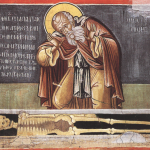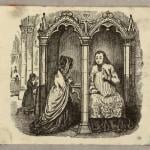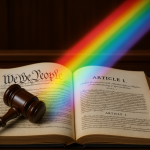MORALITY PLAYS: For the past few weeks I’ve been kicking around various ideas about the relationship between morals and art. I don’t intend this post as a manifesto–more as a series of problems. I go through phases: a year as a journalist, a year as a philosopher, a year as a (fiction) writer. These days I’m 100% writer, and it takes a huge and perhaps detrimental effort to make my fiction synch up with more abstract concerns. So I’m going to present the problems, and tell you how I solve or at least address them in my fiction, and ask for your comments (with the understanding that I didn’t say I’d listen):
1. When I first wanted to write about this topic, about a month ago (so if you think I’m all about the bold gestures, feel free to revise in the face of my obvious cowardice), I wanted to say that our culture today believes in absolute identity and relative morality. We believe that a fifteen-year-old can make some kind of grand unifying statement about his soul and identity, but we don’t believe there’s an overarching moral structure to the world in which he tries to figure out who the heck he is. And I wanted to say that my stories were about the reverse: a world of absolute morality, in conflict with the coruscating individuality of contemporary fabulous Americans.
I still think that’s partly true. I think it’s a decentish beginning of a description of “Desire,” or “Why Can’t He Be You?” (the story that used to be “A Separated Soul”–the one about Nina Trapetto, the ex-abortionist).
2. But that isn’t what I actually believe about morality in art.
What I actually believe is that every artwork implies a set of questions. This, I think, is not negotiable. In order to be great art, a work has to hook into these enduring questions and conflicts.
Not every artwork has to take the same questions seriously. I wrote here a defense of the Western canon precisely because its questions were more important than the questions addressed by other canons, which, presumptively, had equal status from a stylistic point of view. I know that I read the Western canon as an American–and an American who, moreover, believes that the Western canon is a road that leads to an inevitable divergence between Russian and American authors on the one hand, and everyone else on the other. I really believe that. I really think that great literature, since approximately the end of the Elizabethan age, can be divided into “Russian,” “American,” “Imitators of Ditto,” and “Lame, Lame, Lame.”
I think that because I think Russian and American literature correctly identified the moral questions. Is there anybody watching? Is love about self-satisfaction, self-forgetting, self-annihilating, or something else? In Russian and American literature, the individual is the key figure: the self, in negotiation with the broader cultural context, but never accepting himself as merely a nexus of cultural forces. The self, unique, the soul: never the historicist man. Never the man of Marxist, Hegelian, Heideggerian, nor even Rortyan thought.
Any work of art that forms itself outside this moral latticework is unlikely to appeal to me. Any work of art that embeds itself deep within these crises is likely to appeal to me, no matter what position it ultimately takes.
3. It’s possible to lie with pictures. On the far edge of the screen there is pornography, mammy cookie jars, and the many representations of happy servants of the Communist or Nazi states. Tender comrades.
Is it wrong to represent women, black people, kulaks, as less than human? If you say “yes,” you have already accepted the claim at the heart of a moral aesthetics: Great art is a distillation of life, not a dilution of life.











